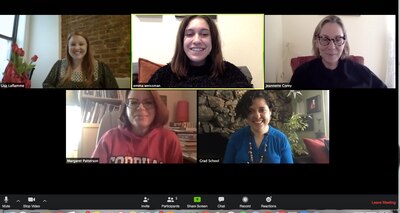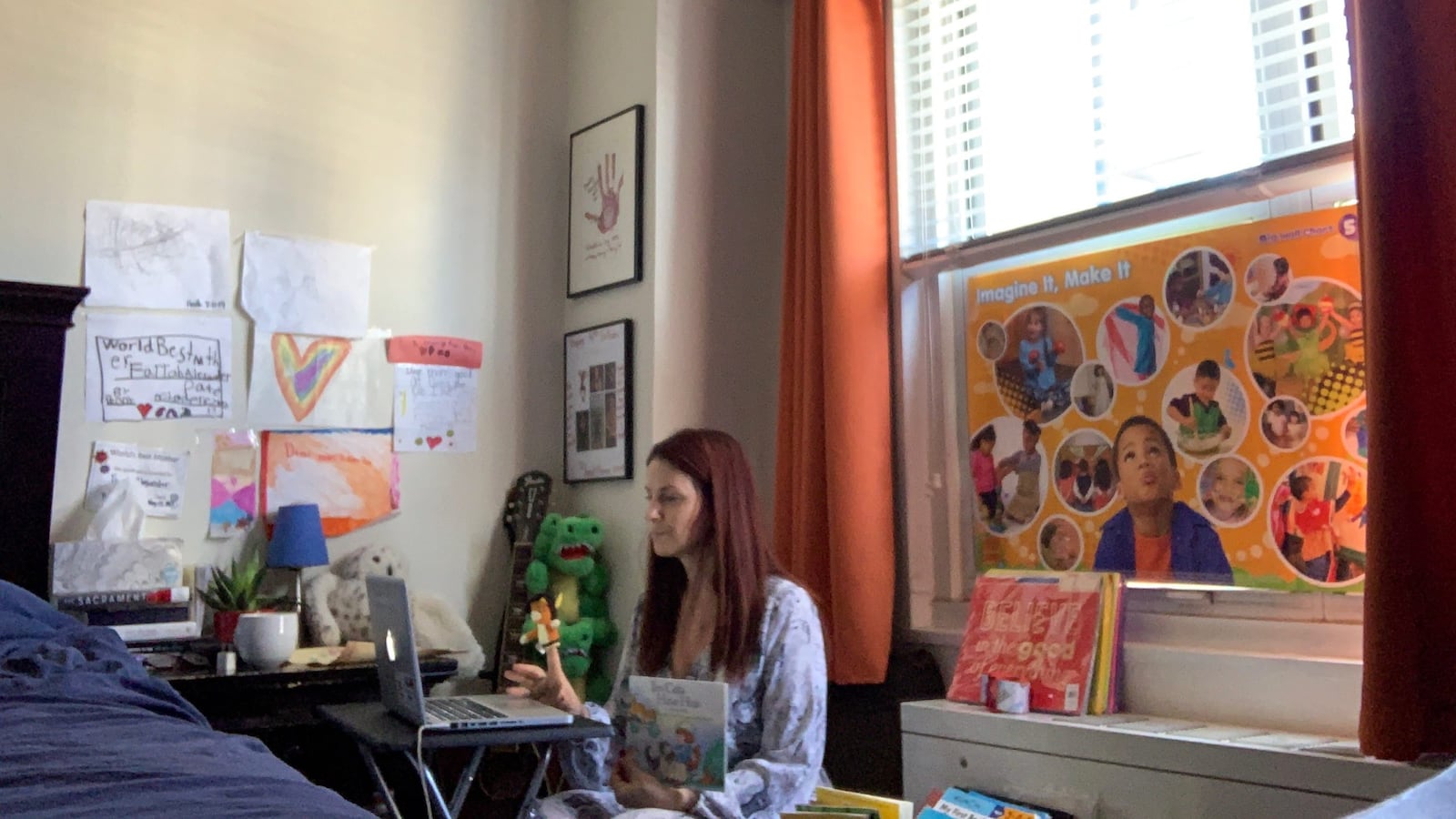A self-described “huggy” pre-K teacher, Farrah Alexander has found it particularly hard to transition to remote learning after New York City closed down its schools amid the new coronavirus pandemic.
“I have kids all over me at any given time,” Alexander said, “So it’s very hard to not be connected to my class and not be able to hug them.”
When the nation’s largest school system switched to remote learning last week, that included about 70,000 preschoolers, most of them ages 3 and 4. Much of preschool focuses on building social connections and learning how simply to be together with other children — skills that are difficult to teach and learn when social distancing has become the norm. It also depends on the nurturing that teachers like Alexander provide, while helping children learn to navigate their own emotions.
That all makes virtual pre-K a unique challenge for educators, who have to balance concerns about screen time for very young children and demands on parents caring for an age group that needs constant attention.
Alexander, who teaches at the Lower East Side’s P.S. 64, has recreated her classroom in the corner of her bedroom, with posters and a stack of books. It serves as the backdrop for recorded videos of puppet shows just like the ones she usually performs in class. In one video, an owl flicks its head side to side while bobbing up and down to a song about shapes. Then, Alexander reads a story and asks questions about what students see on the page, pausing for answers just like she would in the classroom — similar to Fred Rogers in “Mister Rogers’ Neighborhood.”
The aim is to provide something familiar and also sustain emotional connections that propel learning at such a young age.
“The most important thing for pre-K is the socialization and the emotional well being of students, and getting them acclimated to their peers and a classroom environment,” Alexander said. “It’s super important for them to see us, to feel like we’re talking to them, that we’re connecting to them.”
At Bank Street Family Center, which serves about 60 students from six months to five years old, teachers have made an exception to their strict “no screen time” rule, said Jeannette Corey, director of the center. Once a week, teachers hold a class meeting on Zoom so students can come together just like they would in school.
“What we were really thinking about in the very beginning was staying connected to our kids, because we believe learning happens in the context of relationships,” Corey said. “We had to think about, ‘Well how are you going to maintain those connections?”
But online meetings can get chaotic quickly.
“It’s hard to manage a circle in Zoom because there’s lots happening and kids are going on and off the camera,” she said. “Our teachers quickly learned they have to mute the children so they can do anything.”
Teachers also hold one-on-one sessions with students once a week, tailored to the students’ specific interests. In one case, a student had picked up a fascination for cooking, so the teacher recorded herself making macaroni and cheese.
At Bank Street, teachers send a daily email with activities that families can do at home, mirroring what their children might do in school. The activities are demonstrated in homemade videos, creating an online curriculum that parents can tap like they would an on-demand kids’ television show. The format allows parents to control how much time their little ones spend in front of a glowing screen.
Teachers are also thinking about how to support parents offline. One way they’ve done that is by providing prompts and lines of questions that teachers rely on in classrooms to spur imaginative play, rich conversations, and introduce children to new vocabulary.
One teacher uploaded suggestions to her virtual classroom to create an obstacle course in the home, and tie it back to ongoing lessons about the seasons. She told parents they could ask their children to move like springtime animals — hopping like a bunny or a frog. Corey said those kinds of specific suggestions can help parents feel more comfortable in their new

role as both caregiver and teacher.
“This now involves the parent in ways that are different than when we have school,” she said. “Now they’re thinking about this for an extended period, every day.”
At the same time, leaders at East Harlem Scholars Academy have been mindful of the expectations placed on families. After all, most are not trained educators.
The balance that teachers have settled on includes five to 10 minutes of live class time, during which students may sing together or read a book. Then teachers give their students a challenge for the day, which might include stacking materials they have readily at home.
It’s just enough interaction so that screens don’t become “the star of instruction,” said Robert Harvey, superintendent of the charter network. But students can still make a “cognitive connection that this is school, and this is my teacher.”
The network — which runs five schools, serving about 70 pre-K students — has been mindful that students might not have everything they need to learn at home. That’s why they tapped their reserves and donors to quickly buy more than 700 devices and hotspots to deliver to families before classrooms were shuttered.
While scrambling to get students connected, they also sent home picture books and coloring worksheets for the youngest students. Pre-K students need a stimulating environment to learn. In fact, one of the ways that early childhood classrooms are judged for quality is by considering the materials available for play.
If school closures extend beyond the initial April 20 projection — which is highly likely — the academy is thinking about how to provide families with materials for their children to play with, resources akin to textbooks and calculators in older grades.
Desree Cabrall-Njenga, a principal at East Harlem Scholars, is already wondering what it will look like when the children eventually return and will have to re-learn the tasks that help set them up for later grades.
“This whole shift to virtual has been an adjustment for every single one of us — and for the kids especially,” she said.
Alexander, the pre-K teacher on the Lower East Side, said the citywide shutdown came at the point in the school year when things start to “click in place” for students.
“This is the time when you see them grow so much as little people and learners,” she said.
While she’s worried about what that means for her students, she knows they’re not alone. She understands the concerns firsthand since she’s also the mother of a pre-K student. She has seen her son struggle with understanding why he’s not in school even though she’s explained it to him. He misses his teacher and his friends. She worries that he is not getting the full social-emotional experience of pre-K from home.
“People are nervous for, is there going to be school again for the rest of this year? And if not what does that look like for my kid,” Alexander said. “We are all in these uncharted waters together, and kids are very resilient, and people are very resilient.”
This article answers questions raised by our readers. Share your coronavirus-related questions, concerns, and ideas by emailing us at community@chalkbeat.org, and keep up with our reporting on COVID-19 here.

